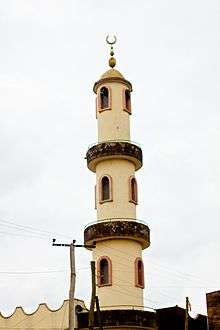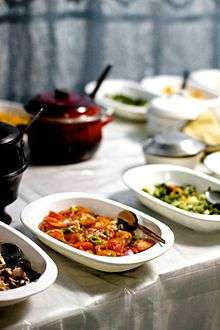Jimma
| Jimma | |
|---|---|
| Town | |
 Jimma Location within Ethiopia | |
| Coordinates: 7°40′N 36°50′E / 7.667°N 36.833°ECoordinates: 7°40′N 36°50′E / 7.667°N 36.833°E | |
| Country | Ethiopia |
| Region | Oromia |
| Zone | Jimma Special Zone |
| Elevation | 1,780 m (5,840 ft) |
| Population (2012) | |
| • Total | 207,573 |
| Time zone | EAT (UTC+3) |
| Area code(s) | 47 |
Jimma (Oromo: Jimma, Amharic: ጅማ?), also spelled Jima, is the largest city in south-western Ethiopia. It is a special zone of the Oromia Region and is surrounded by Jimma Zone. It has a latitude and longitude of 7°40′N 36°50′E / 7.667°N 36.833°E. The town was the capital of Kaffa Province until the province was dissolved. Prior to the 2007 census, Jimma was reorganized administratively as a special Zone.
Herbert S. Lewis states that in the early 1960s it was "the greatest market in all of south-western Ethiopia. On a good day in the dry season it attracts up to thirty thousand people."[1]
History

What is now Jimma's northern suburb of Jiren was the capital of a large Oromo kingdom until the late 19th century. Originally named Hirmata, the city owed its importance in the 19th century to being located on the caravan route between Shewa and the Kingdom of Kaffa, as well as being only six miles from the palace of the king of Jimma.
According to Donald Levine, in the early 19th century the market attracted thousands of people from neighboring regions: "Amhara from Gojjam and Shoa, Oromo from all the Gibe Kingdoms and numerous representatives of the Lacustrine and Omotic groups, including Timbaro, Qabena, Kefa, Janjero, Welamo, Konta and several others".[2]
The present town was developed on the Awetu River by the Italian colonial regime in the 1930s. At that time, with the goal of weakening the native Ethiopian Church, the Italians intended to make Jimma an important center of Islamic learning, and founded an academy to teach fiqh.[3] In the East African fighting of World War II after their main force was defeated, the Italian garrison at Jimma was one of the last to surrender, holding out til July 1941.
Jimma was the scene of a violent encounter which started in April 1975 between radical college students (known as zemacha) sent to organize local peasants, who had benefited from land reform, and local police, who had sided with local landowners. Students and peasant followers had imprisoned local small landowners, rich peasants and members of the local police force; this action led to further unrest, causing the Derg (the ruling junta) to send a special delegation to Jimma, which sided with the local police. In the end, 24 students were killed, more arrested, and the local zemacha camps closed.[4]
Days before the end of the Ethiopian Civil War in May 1991, the city was captured by the Ethiopian People's Revolutionary Democratic Front.
On 13 December 2006, the Ethiopian government announced that it had secured a loan of US$98 million from the African Development Bank to pave the 227 kilometers of highway between Jimma and Mizan Teferi to the southwest. The loan would cover 64% of the 1270.97 million Birr budgeted for this project.[5]
Climate
Jimma has a tropical rainforest climate (Af) under the Köppen climate classification. It features a long annual wet season from March to October.
Temperatures at Jimma are in a comfortable range, with the daily mean staying between 20°C and 25°C year-round.
| Climate data for Jimma | |||||||||||||
|---|---|---|---|---|---|---|---|---|---|---|---|---|---|
| Month | Jan | Feb | Mar | Apr | May | Jun | Jul | Aug | Sep | Oct | Nov | Dec | Year |
| Average high °C (°F) | 28 (82) |
29 (84) |
28 (82) |
27 (81) |
26 (79) |
24 (75) |
24 (75) |
25 (77) |
27 (81) |
27 (81) |
28 (82) |
28 (82) |
26.8 (80.1) |
| Daily mean °C (°F) | 23 (73) |
24 (75) |
24 (75) |
23.5 (74.3) |
23 (73) |
21.5 (70.7) |
21.5 (70.7) |
22 (72) |
23 (73) |
23 (73) |
23 (73) |
22.5 (72.5) |
22.83 (72.93) |
| Average low °C (°F) | 18 (64) |
19 (66) |
20 (68) |
20 (68) |
20 (68) |
19 (66) |
19 (66) |
19 (66) |
19 (66) |
19 (66) |
18 (64) |
17 (63) |
18.9 (65.9) |
| Average rainfall mm (inches) | 40 (1.57) |
55 (2.17) |
95 (3.74) |
140 (5.51) |
160 (6.3) |
215 (8.46) |
215 (8.46) |
215 (8.46) |
185 (7.28) |
90 (3.54) |
55 (2.17) |
35 (1.38) |
1,500 (59.04) |
| Average rainy days | 5 | 10 | 14 | 15 | 18 | 24 | 25 | 25 | 22 | 18 | 10 | 5 | 191 |
| Source: World Climates[6] | |||||||||||||
Demographics
Based on the 2007 Census conducted by the Central Statistical Agency of Ethiopia (CSA), this Zone has a total population of 120,960, of whom 60,824 are men and 60,136 women. With an area of 50.52 square kilometers, Jimma has a population density of 2,394.30 all are urban inhabitants. A total of 32,191 households were counted in this Zone, which results in an average of 3.76 persons to a household, and 30,016 housing units. The three largest ethnic groups reported in Jimma were the Oromo (46.71%), the Amhara (17.14%) and the Dawro (10.05%); all other ethnic groups made up 26.1% of the population. Amharic was spoken as a first language by 41.58% and 39.96% spoke Afan Oromo; the remaining 18.46% spoke all other primary languages reported. The majority of the inhabitants said they practiced Ethiopian Orthodox Christianity, with 46.84% of the population reporting they observed this belief, while 39.03% of the population were Muslim, and 13.06% were Protestant.[7]
The national 1994 census reported this town had a total population of 88,867, of whom 43,874 were men and 44,993 were women.
Points of interest

Some buildings survive from the time of the Jimma Kingdom, including the Palace of Abba Jifar. The city is home to a museum, Jimma University, several markets, and an airport (ICAO code HAJM, IATA JIM). Also of note is the Jimma Research Center, founded in 1968, which is run by the Ethiopian Institute of Agricultural Research. The Center specializes in agricultural research, including serving as the national center for research to improve the yield of coffee and spices.[8]
Notable residents
- King Abba Jifar I
- King Abba Jifar II
References
- ↑ Herbert S. Lewis, A Galla Monarchy: Jimma Abba Jifar, Ethiopia, 1830-1932 (Madison: University of Wisconsin Press, 1965), p. 56.
- ↑ Donald N. Levine, Greater Ethiopia, second edition (Chicago: University Press, 1974)
- ↑ J. Spencer Trimingham, Islam in Ethiopia (Oxford: Geoffrey Cumberlege for the University Press, 1952), p. 137.
- ↑ Marina and David Ottaway, Ethiopia: Empire in Revolution (New York: Africana, 1978), p. 73f
- ↑ "Ethiopian Embassy Newsletter", Nov/Dec 2006, p.2, Ethiopian Embassy to the UK website (accessed 11 January 2007)
- ↑ "Jimma Climate". Retrieved 20 February 2016.
- ↑ 2007 Population and Housing Census of Ethiopia: Results for Oromia Region, Vol. 1, Tables 2.1, 2.5, 3.4 (accessed 13 January 2012)
- ↑ EARI list of research centers (accessed 30 April 2009)
External links
- Cities of Ethiopia: Jimma by John Graham (Addis Tribune, 21 December 2001)
- Jimma University
- Jimma Times
- MSN Map